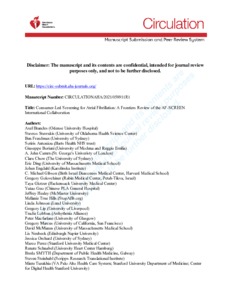Brandes, A;
Stavrakis, S;
Freedman, B;
Antoniou, S;
Boriani, G;
Camm, AJ;
Chow, CK;
Ding, E;
Engdahl, J;
Gibson, MM;
et al.
Brandes, A; Stavrakis, S; Freedman, B; Antoniou, S; Boriani, G; Camm, AJ; Chow, CK; Ding, E; Engdahl, J; Gibson, MM; Golovchiner, G; Glotzer, T; Guo, Y; Healey, JS; Hills, MT; Johnson, L; Lip, GYH; Lobban, T; Macfarlane, PW; Marcus, GM; McManus, DD; Neubeck, L; Orchard, J; Perez, MV; Schnabel, RB; Smyth, B; Steinhubl, S; Turakhia, MP
(2022)
Consumer-Led Screening for Atrial Fibrillation: Frontier Review of the AF-SCREEN International Collaboration.
Circulation, 146 (19).
pp. 1461-1474.
ISSN 1524-4539
https://doi.org/10.1161/CIRCULATIONAHA.121.058911
SGUL Authors: Camm, Alan John
![[img]](https://openaccess.sgul.ac.uk/115029/1.hassmallThumbnailVersion/Consumer%20led%20screening%20AAM.pdf)  Preview |
|
PDF
Accepted Version
Available under License ["licenses_description_publisher" not defined].
Download (1MB)
| Preview
|
Abstract
The technological evolution and widespread availability of wearables and handheld ECG devices capable of screening for atrial fibrillation (AF), and their promotion directly to consumers, has focused attention of health care professionals and patient organizations on consumer-led AF screening. In this Frontiers review, members of the AF-SCREEN International Collaboration provide a critical appraisal of this rapidly evolving field to increase awareness of the complexities and uncertainties surrounding consumer-led AF screening. Although there are numerous commercially available devices directly marketed to consumers for AF monitoring and identification of unrecognized AF, health care professional-led randomized controlled studies using multiple ECG recordings or continuous ECG monitoring to detect AF have failed to demonstrate a significant reduction in stroke. Although it remains uncertain if consumer-led AF screening reduces stroke, it could increase early diagnosis of AF and facilitate an integrated approach, including appropriate anticoagulation, rate or rhythm management, and risk factor modification to reduce complications. Companies marketing AF screening devices should report the accuracy and performance of their products in high- and low-risk populations and avoid claims about clinical outcomes unless improvement is demonstrated in randomized clinical trials. Generally, the diagnostic yield of AF screening increases with the number, duration, and temporal dispersion of screening sessions, but the prognostic importance may be less than for AF detected by single-time point screening, which is largely permanent, persistent, or high-burden paroxysmal AF. Consumer-initiated ECG recordings suggesting possible AF always require confirmation by a health care professional experienced in ECG reading, whereas suspicion of AF on the basis of photoplethysmography must be confirmed with an ECG. Consumer-led AF screening is unlikely to be cost-effective for stroke prevention in the predominantly young, early adopters of this technology. Studies in older people at higher stroke risk are required to demonstrate both effectiveness and cost-effectiveness. The direct interaction between companies and consumers creates new regulatory gaps in relation to data privacy and the registration of consumer apps and devices. Although several barriers for optimal use of consumer-led screening exist, results of large, ongoing trials, powered to detect clinical outcomes, are required before health care professionals should support widespread adoption of consumer-led AF screening.
| Item Type: |
Article
|
| Additional Information: |
This is a non-final version of an article published in final form in Brandes, A; Stavrakis, S; Freedman, B; Antoniou, S; Boriani, G; Camm, AJ; Chow, CK; Ding, E; Engdahl, J; Gibson, MM; et al. (2022) Consumer-Led Screening for Atrial Fibrillation: Frontier Review of the AF-SCREEN International Collaboration. Circulation, 146 (19). pp. 1461-1474. |
| Keywords: |
atrial fibrillation, screening, wearable electronic devices, Humans, Aged, Atrial Fibrillation, Electrocardiography, Stroke, Mass Screening, Risk Factors, Humans, Atrial Fibrillation, Electrocardiography, Mass Screening, Risk Factors, Aged, Stroke, atrial fibrillation, screening, wearable electronic devices, Aged, Atrial Fibrillation, Electrocardiography, Humans, Mass Screening, Risk Factors, Stroke, atrial fibrillation, screening, wearable electronic devices, 1102 Cardiorespiratory Medicine and Haematology, 1103 Clinical Sciences, 1117 Public Health and Health Services, Cardiovascular System & Hematology |
| SGUL Research Institute / Research Centre: |
Academic Structure > Molecular and Clinical Sciences Research Institute (MCS) |
| Journal or Publication Title: |
Circulation |
| ISSN: |
1524-4539 |
| Language: |
eng |
| Publisher License: |
Publisher's own licence |
| Projects: |
| Project ID | Funder | Funder ID |
|---|
| R01 HL161008 | NHLBI NIH HHS | UNSPECIFIED | | R25 MD011564 | NIMHD NIH HHS | UNSPECIFIED |
|
| PubMed ID: |
36343103 |
| Web of Science ID: |
WOS:000878746300011 |
 |
Go to PubMed abstract |
| URI: |
https://openaccess.sgul.ac.uk/id/eprint/115029 |
| Publisher's version: |
https://doi.org/10.1161/CIRCULATIONAHA.121.058911 |
Statistics
Item downloaded times since 01 Dec 2022.
Actions (login required)
 |
Edit Item |



